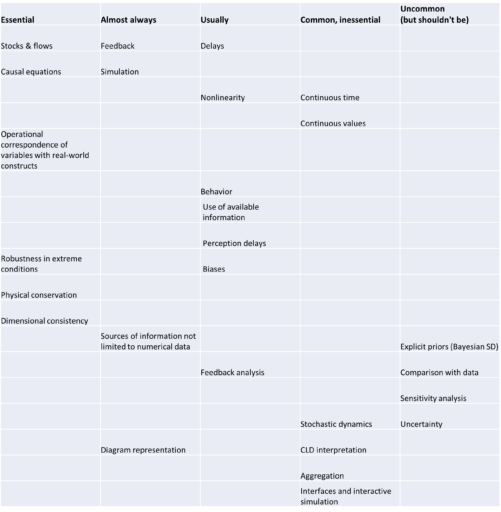Asmeret Naugle, Saeed Langarudi, Timothy Clancy propose to define System Dynamics in a new paper.
The defining characteristics are: (1) models are based on causal feedback structure, (2) accumulations and delays are foundational, (3) models are equation-based, (4) concept of time is continuous, and (5) analysis focuses on feedback dynamics.
I like the paper, but … not so fast. I think more, and more flexible, criteria are needed. I would use the term “characterize” rather than “define.” The purpose should be to aid recognition of SD, and hopefully good SD, without drawing too tight a box around the field.
I particularly disagree with the inclusion of continuous time. Even though discrete time stinks, I think continuous time is a common but inessential feature, like continuous flows. Many models include occasional discrete events, and sometimes they’re important. Ventity’s actions are explicit discrete events between time steps, and they may modify model structure in ways that are key to an operational representation of reality.
My top-of-mind alternative framework looks like:
I think it’s also helpful to describe things that are not SD:
- Intertemporal optimization or rational expectations representing behavior
- Computable general equilibrium
- Linear regression
- Linear programming
- Mixed integer programming
- Social Network Analysis (static)
- Discrete ABM
- Discrete event simulation
- Equilibrium
- Simultaneity
Sometimes it’s easier to see the negative space, but there are exceptions to these rules.
I think it’s notable that both frameworks exclude a variety of qualitative systems thinking approaches, like group model building or elicitation methods that create CLDs rather than simulatable models. I’m a big tent fan, and certainly some of the exceptions are common at the SD conference, but does that make them SD?
I think behavior is another challenging feature to describe. In my mind, System Dynamics is almost synonymous with behavioral dynamics. If you’re building an economic model in which agents explicitly know the future (e.g., via intertemporal optimization), it’s not an SD model (though you might be using it as a comparison case for some SD purpose). Yet there’s a strong tradition of prize-winning biomedical models that lack behavior because they lack human agency. These are not easily distinguishable from what other fields might call ODEs or nonlinear dynamics. I would not want to eject those from the field, but neither would I want this to become our focus.
I’ll be interested to see how the conversation evolves on this.


Thanks for jumping in in this Tom, we’re really hoping that this will be the start of a useful and interesting conversation. I wanted to clarify what we’re saying about the concept of continuous time. We agree that some SD model components can (and maybe sometimes should?) be discrete. What we’re pointing out is that the field thinks of time itself as a continuous thing. Models that simulate based on ticks, or only based on discrete events without a background concept of time, aren’t really part of the field.
I’m also a big tent fan and consider qualitative methods to be important to the field, but different from SD modeling itself. I think putting more clarity on our definitions can help us improve contributions across the board.
I think we agree on the perspective on time. Your suggested definition is good, because it cuts out DES, some ABM and other bad discrete approaches (maybe also statics that have no time). OTOH, many games, and even Euler integration, are hard to distinguish from some discrete time models – mainly the notation differs, in which case the discrete time models may fail the “has stocks” test.
I would still favor demoting time in the list. There are at least two parts of the genome that I think are more important: realistic representation of behavior, and emphasis on model quality and testing (units, robustness, etc.).
George Richardson would say that endogeneity is critical. (And I’d agree with him).
Wow, how did I miss that one? George’s paper on endogenous perspective is linked in this post: https://metasd.com/2019/07/closing-the-loops/
Then there’s lack of endogeneity: https://metasd.com/2016/09/dead-buffalo-diagrams/
Another perspective on what’s important for modeling (outside SD): https://metasd.com/2022/08/grand-challenges-socioeconomic-systems-modeling/
I’m partial to simple definitions, for complex definitions of a field often make me think of counting angels on the head of a pin.
As to discrete vs. SD, I’m partial to John Sterman’s comment in https://www.ventanasystems.co.uk/forum/viewtopic.php?p=2929#p2929 : “the essence of system dynamics is the feedback perspective.” (from a thread called “Discrete Event Simulation v. System Dynamics)
Once you have feedback, don’t you get most of the other things you’re discussing? For example, endogeneity comes out of certain types of feedback systems–but you could also get (quasi-)endogeneity by modeling a ROM table of sine values that’s driven only by time.
Incidentally, I think my comment to which John was referring is my note there from April 18, although I cannot explain the time-stamps on John’s and my notes. I recall being puzzled at the time, too. Maybe there’s an earlier posting from me that predates John’s; I haven’t found it yet.
Somewhere I recall a similar definition being the application of the mindset of the controls engineer to what Coyle called “managed systems.”
Perhaps we should borrow the Supreme Court’s definition, “I’ll know it when I see it.”
The ‘feedback perspective’ definition is attractive for brevity. And, as you say, it requires some of the other things (stocks, for example). However, I’m not sure it solves the problem, because people outside the field don’t know what we mean by that.
This takes me back to the premise of this exercise, which is in the abstract, “A clear definition of system dynamics modeling can provide shared understanding and clarify the impact of the field.” I’m finding myself a little fuzzy on the question. Do we think practitioners are unclear on these things, or are we trying to improve branding to others, or … ? Is this a leverage point for growth of the field, or angels & pins?